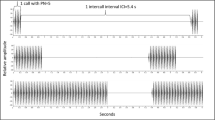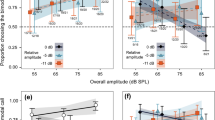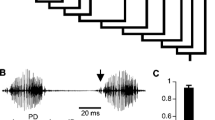Abstract
The function of call alternation in the African painted reed frog, Hyperolius marmoratus was studied. Males actively avoided call overlap with neighboring males in their natural habitat. Advertisement calls produced by groups of two or three males showed less overlap than expected if they called at random. In addition, isolated males significantly reduced their calling rate to match the periodicity of a playback of periodic tone pulses, with vocalizations given during the silent intervals between tones. Gap-detection experiments showed that males suppressed vocalizations during playbacks of constant-frequency tone bursts and gave more calls during silent periods than expected by chance. Females discriminated against conspecific advertisement calls with many pulses in favor of calls with few or no pulses. This suggests that there would be little selection pressure on males to alternate calls so that pulses are not obscured. To test if call alternation functions to make calls more conspicuous, females were presented with identical conspecific advertisement calls from two speakers in four different temporal patterns: simultaneous, overlapping, abutting, and alternating. Females did not discriminate when calls were presented in a simultaneous, abutting, or alternating time pattern. When calls overlapped with the trailing call delayed from 0.5 to 70 ms females discriminated in favor of the leading call. When the intensity of the leading call was reduced by 6 dB the preference for the leading call was maintained when calls overlapped by 2 and 40 ms but was abolished or reversed at 0.5 and 70 ms, respectively. These results support the notion that the second of two partially overlapping calls was acoustically masked, rendering female painted reed frogs unwilling to approach or unable to locate such calls. It is suggested that either simultaneous masking or the precedence effect are responsible for the observed behavior. Acoustic masking of the second call by the first when calls overlapped was maintained even when the frequency of the first call was altered by 150 Hz above and below the more preferred frequency of the second call.
Article PDF
Similar content being viewed by others
Avoid common mistakes on your manuscript.
Author information
Authors and Affiliations
Additional information
Received: 13 April 1995/Accepted after revision: 5 November 1995
Rights and permissions
About this article
Cite this article
Grafe, T. The function of call alternation in the African reed frog (Hyperolius marmoratus): precise call timing prevents auditory masking. Behav Ecol Sociobiol 38, 149–158 (1996). https://doi.org/10.1007/s002650050227
Issue Date:
DOI: https://doi.org/10.1007/s002650050227




